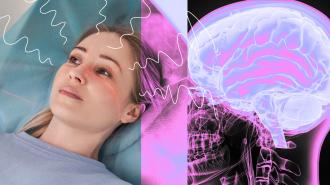Beaming focused ultrasound waves into the heads of Alzheimer’s patients helped a drug clear more plaques from their brains — and the same technique could make countless other meds more effective.
The challenge: The blood-brain barrier is a protective membrane between your brain and circulatory system, and its purpose is to keep harmful substances in your blood, such as bacteria and viruses, out of your brain.
While the benefits of this are obvious, there’s also a downside: the vast majority of drugs don’t readily cross the blood-brain barrier. That’s a problem if you need to target something in the brain. Patients often need to take large, frequent doses for their meds to be effective, leading to more side effects and higher costs.
What’s new? Researchers at the West Virginia University (WVU) Rockefeller Neuroscience Institute (RNI) have now published the results of a first in-human study testing the use of a technique called “focused ultrasound” to help an Alzheimer’s drug pass through the blood-brain barrier.
“We observed an average of 32% more reduction in amyloid-beta plaques.”
Ali Rezai
During the study, three patients with mild Alzheimer’s received IV infusions of aducanumab, a drug designed to clear amyloid-beta plaques from the brain. Right after that, they donned a special helmet and laid down in an MRI machine.
A solution containing microscopic bubbles was then injected into their bloodstreams. Using the MRI for guidance, the researchers could beam focused ultrasound waves from the helmet directly into a part of the patient’s brain with high amyloid-beta plaques.
The ultrasound pulses caused the microbubbles in that area to vibrate. This created tiny openings in the blood-brain barrier that allowed more of the Alzheimer’s drug to enter the brain — based on previous focused ultrasound research, these tiny holes close up within 48 hours.
Each patient underwent the procedure six times. The researchers then measured the plaque levels in the treated part of their brain and the same region on the other side of their head — and saw a significant difference.
“[W]e observed an average of 32% more reduction in amyloid-beta plaques … in brain areas with blood-brain barrier opening compared to areas with no such opening,” said Ali Rezai, the study’s lead author.
Looking ahead: Aducanumab is administered every 3 to 4 weeks for at least a year, with an average annual cost of $28,200. If focused ultrasound can get more of the drug into patients’ brains, that could mean less spending and fewer trips to the clinic.
Still, this was a small study, and we’ll need to wait for larger trials to confirm the results, as well as prove that opening the blood-brain barrier in this way, even temporarily, is safe.
The big picture: Rezai’s team is one of several exploring the use of focused ultrasound to get drugs into the brain — others have used the technique to help treat children with brain tumors and adults with ALS.
Still others are looking at different ways to crack through the blood-brain barrier, including implantable pumps, drug-carrying nanoparticles, and even meds that temporarily weaken the membrane — suggesting that the barrier might not stand between us and more effective drug treatments for much longer.
We’d love to hear from you! If you have a comment about this article or if you have a tip for a future Freethink story, please email us at tips@freethink.com.
